Beyond the Chiron Gate is now firmly in the adding more stuff stage of development, and I’m making good progress. This month I’ve made some minor mechanical tweaks but mostly spent the time adding new things to discover to do with life and civilisations.
New Life…
The basic mechanic of the game is that you see a mysterious thing on a planet (e.g. regular-looking structures), and then investigate it to find out what it is (e.g. alien cities).
Which is great, but when life or a civilisation appears on a planet, I want the game to add a bunch of related traits to make it interesting. If all of these traits are visible from orbit, it ends up being obvious which planets have life or a civilisation, because inhabited planets have a dozen explorable traits whereas lifeless planets have one or two.
So, this month I’ve added a bunch of new life/civilisation traits that aren’t visible from orbit, but that become visible once you’ve discovered the existence of life/civilisation on that planet.
How it works now is: a planet will have two or three visible-from-orbit traits that you can investigate. One of these might reveal the presence of life on a planet. An oxygen-nitrogen atmosphere is often, but not always, a clue that life exists…
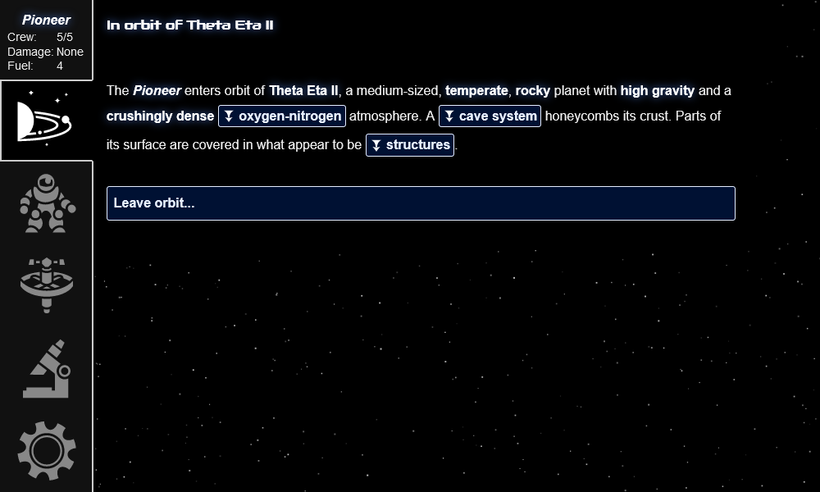
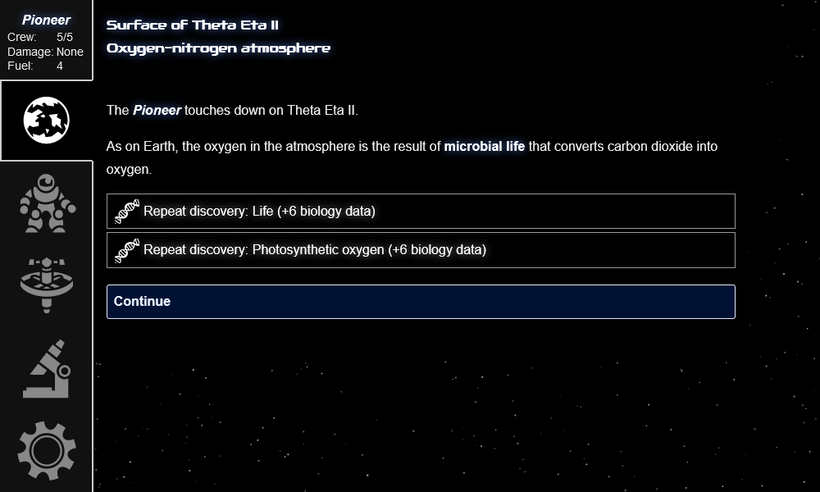
Once you’ve discovered life, it appears as an explorable trait on planet view. Exploring it means your explorers do a survey of the planet’s ecosystem. This will tell you basic info about the planet’s life (what parts of the planet it lives in, how complex it is), and also reveal one or more mystery traits.
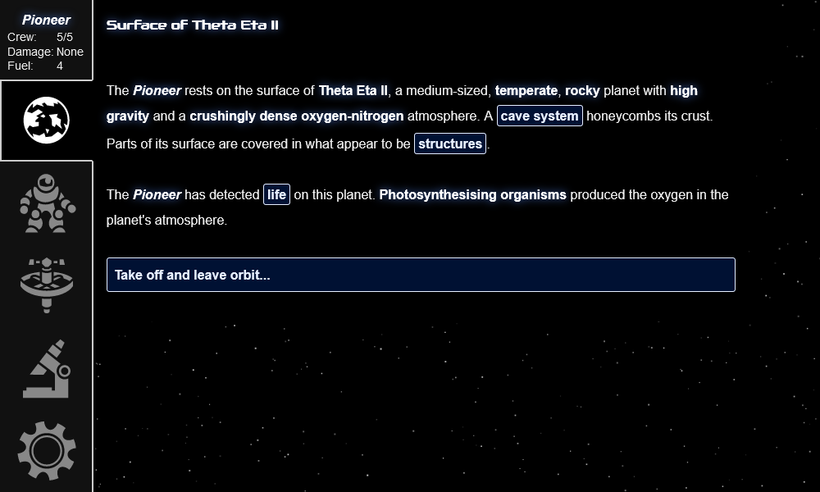
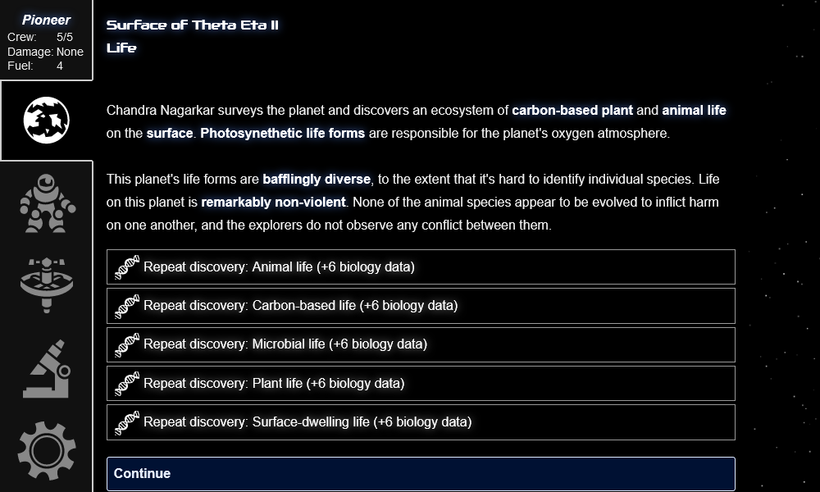
These mystery traits then appear on planet view and can be explored to find out what’s behind them.
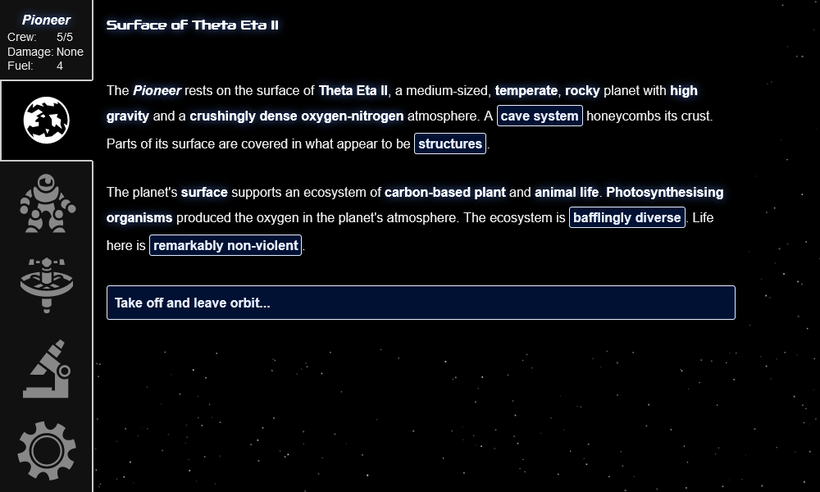
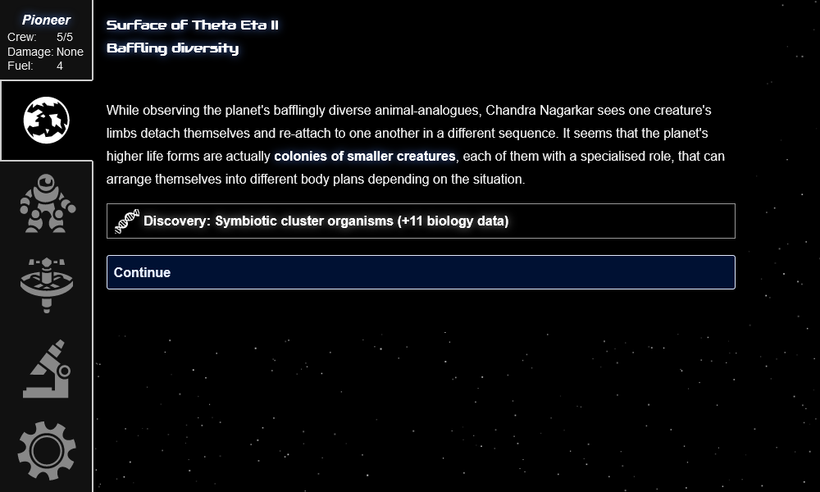
What this means is that a planet with life will have a bunch of life-related things to explore, but most of them aren’t visible until you’ve discovered the existence of life on the planet, so at first glance you don’t know if a planet has life or not.
…And New Civilisations
Civilisations work in a similar way. You can discover the existence of a civilisation by investigating a trait, either one that’s visible from orbit (e.g. structures that turn out to be cities) or one that’s revealed when you discovered life (e.g. animals with complex behaviour that turn out to be sapient). Once you’ve discovered it, it shows up on planet view as an explorable trait.
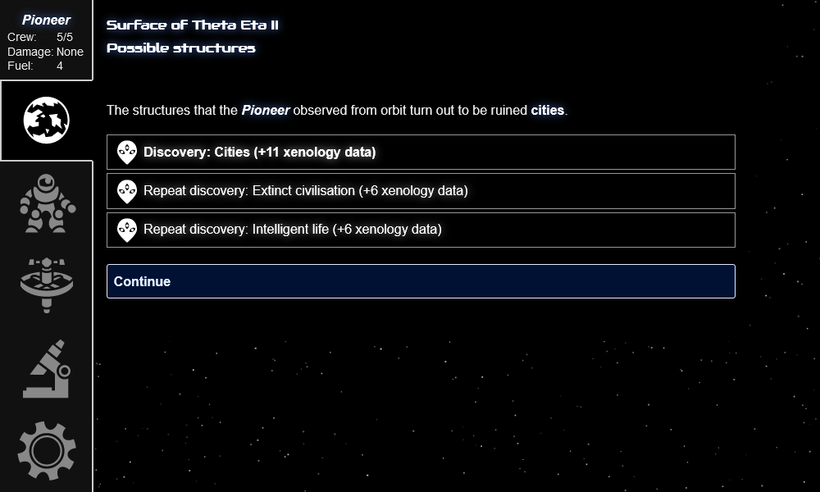
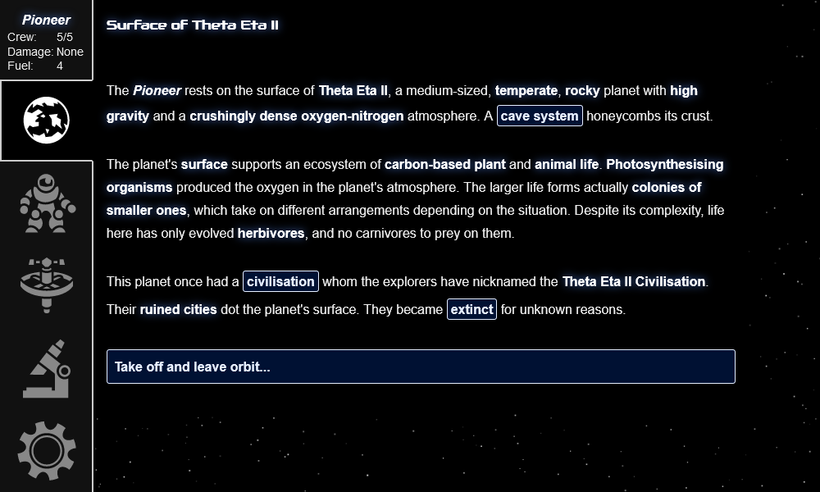
Side note: a balancing change I’ve made this month is that extinct civilisations are now more common compared to living ones. The universe is old, and intelligent species don’t last long.
Exploring the civilisation trait means attempting to make peaceful contact in the case of a living civilisation, or deciphering its language in the case of a dead one. You learn basic information (their body shape, diet, and tech level), and one or more mystery traits. In the case of an extinct civilisation, the reason for their extinction will be another mystery trait.
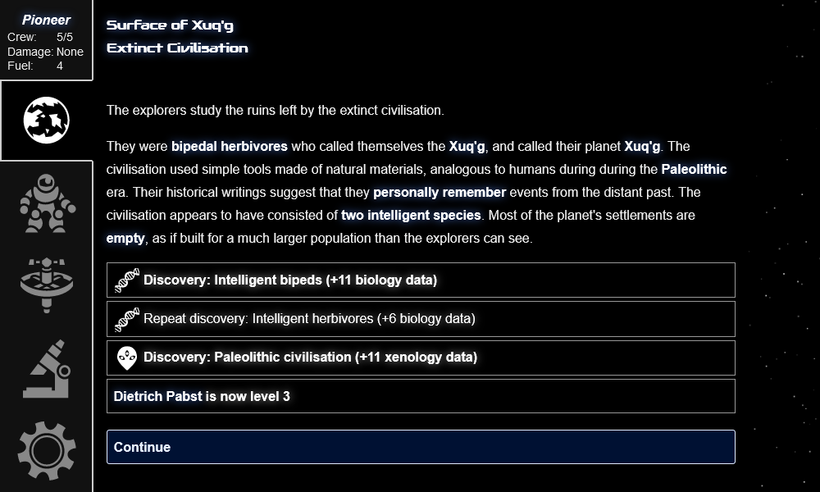
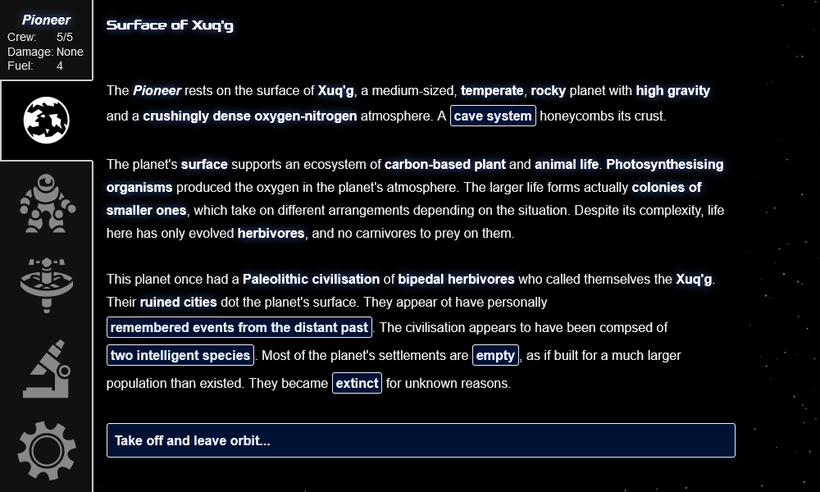
As with life mysteries, you can investigate them to find out the resolution to the mystery.
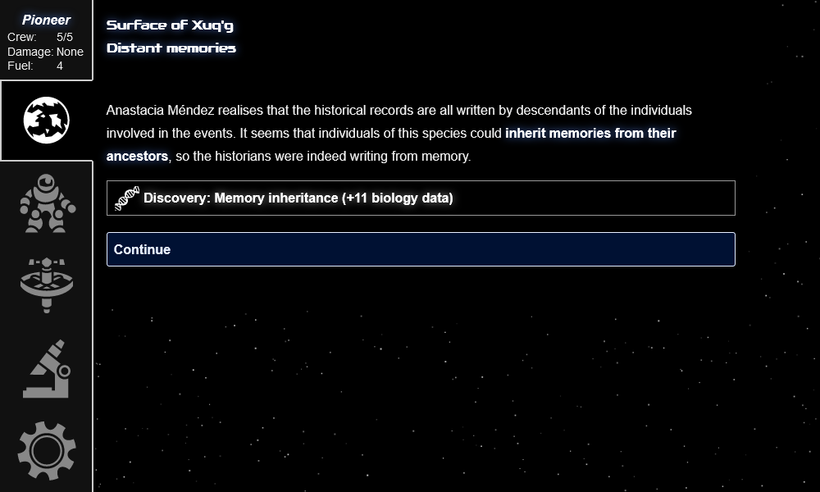
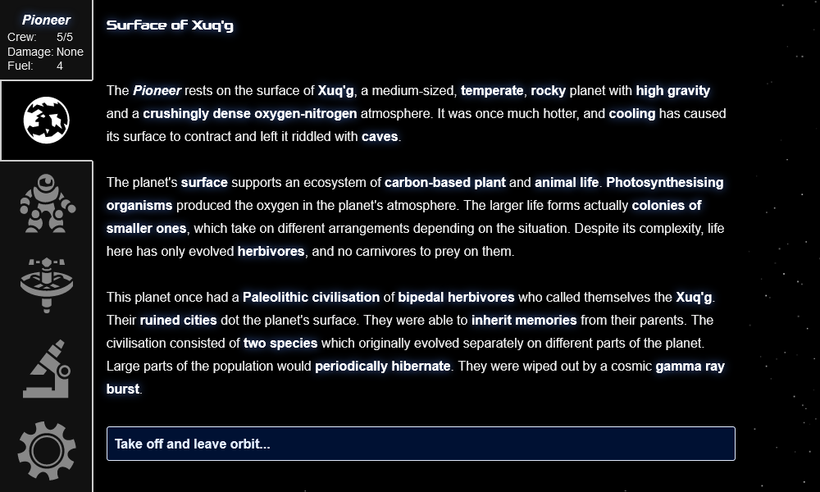
Overall, an inhabited planet can have a lot of stuff to explore, but you might have no idea it’s there until you start exploring.
Planet What-Is-This-Biped-Saying?
Something I’ve been meaning to add for ages and have finally got round to this month is that civilisations now have names for their own planets, as well as names for themselves. If you manage to make contact with a civilisation (or decipher a dead civilisation’s language), the first thing you learn is their name for themselves and for their home planet, and the game then uses that name to refer to the planet from then on.
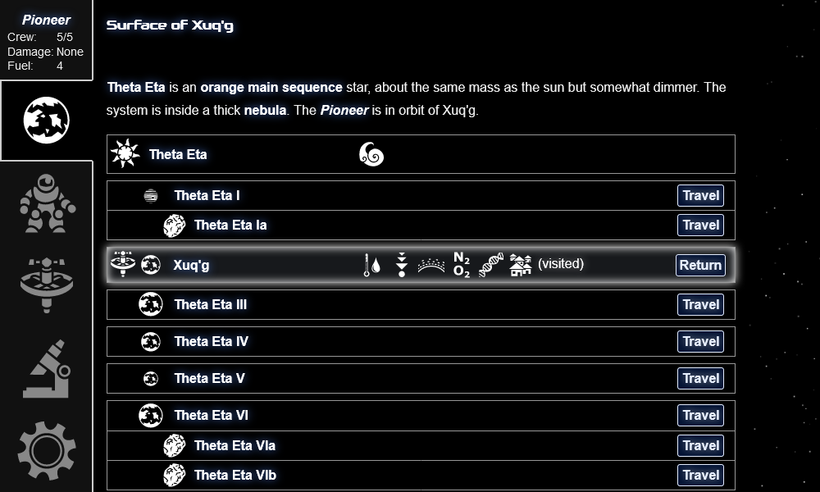
(In the screenshots above, it’s just a coincidence that the game picked Xuq’g as the name for both the civ and the planet. Usually the names will be different.)
Still to do: come up with a way of generating two names that sound like they’re related to each other or at least produced by the same creatures’ vocal cords. Right now it just picks two names from the same name list.
For the sake of simplicity, each alien civilisation has one name for itself and one name for its planet–or rather, you’re using the language of the first representatives of that civ that you meet. (Also, it’s possible these names actually mean “what is this biped talking about?” or “the ground”.) It’s a big simplification, but I wanted to give the impression that the explorers are at least trying to communicate with the aliens in their own language.
Also for the sake of simplicity, all aliens have names for themselves that can be rendered in English letters, even if that’s not really plausible.
Fuel is back
In a change that I’m not certain about and might reverse, I’ve added fuel back into the game. One fuel unit gets expended each time you travel between planets, and you’re forced to use the last unit to return to the Gate.
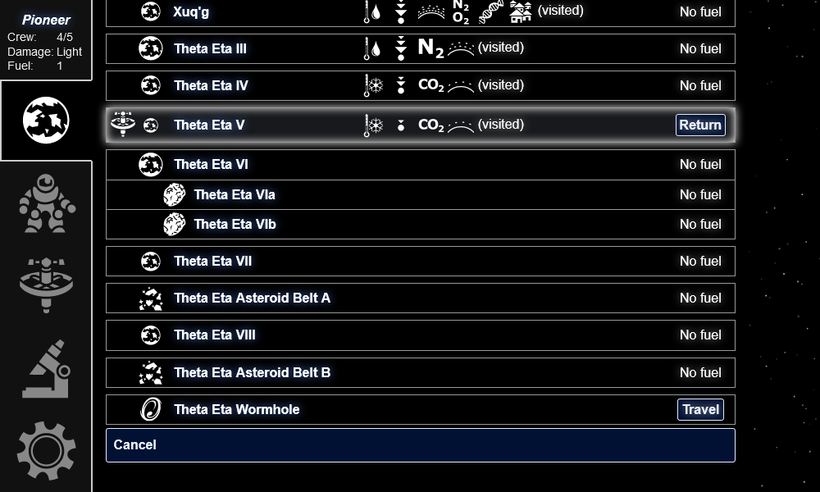
The problem I was having was that, playing the game, I felt a completionist urge to fully explore every planet in a system. That’s not a fun or optimal way to play, because most planets are boring and the game’s progression is meant to be about getting better at identifying which planets will be interesting so that you can go straight for them. But the desire to flip unexplored things to explored things was very strong, even though it meant putting my poor crew members at risk of horrible space death just to explore every lifeless asteroid.
My current idea is that if you can only visit X planets each system (because of fuel), you get an interesting gameplay question of “which are the most promising X planets?”, rather than a desire to mechanically click on the planets one by one.
I might replace fuel with something else, but I think a hard, visible-up-front limit on how many planets you can visit per system is something the game needs.
Next: more events
That’s it for this month. I think I’m close to having enough planet, life, and civilisation traits for a minimum viable game (i.e. the version I’d get people to playtest). The main thing that’s missing now is more events to go along with them, and that’s what I’m intending to work on next month.
Thanks for sticking with me through this development process. I’m finding that writing these monthly dev diaries is helpful for my process, so I hope you find them interesting as well!
